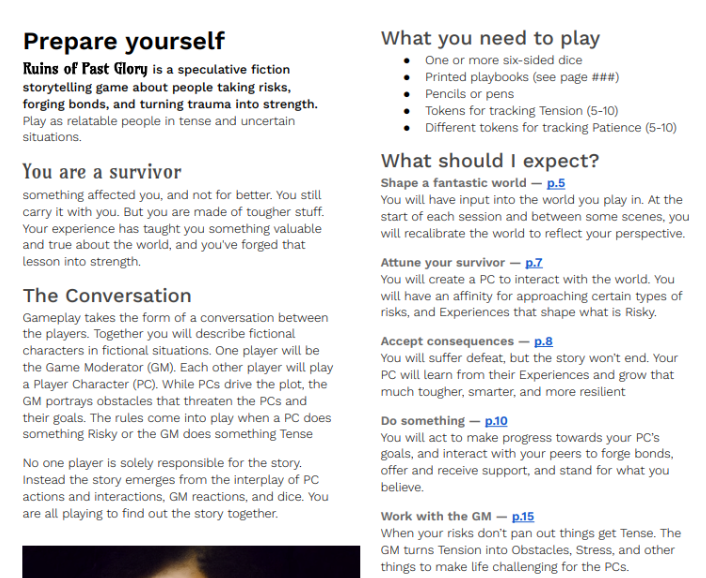I had a busy few months but I am back with a vengeance a need for more cowbell the inability to write a proper opening. I have a few blog posts lined up to keep consistent posting again once a month. I wanted to change the format of my design reviews to allow me to dive deeper into the RPG and provide more examples we can all learn from when making our own.
Late 2022 and early 2023 I took an in depth look at Ruins of Past Glory, a tabletop RPG about the thrill of survival and the power of relationships developed by Elo Lewis. Right off the bat I liked the first page. It had a clear format and appropriately set my expectations for the rest of the book.
Looking at the image on the right. We can see the game pillars right in the first paragraph. Then we have framing for the world below on the left. That is followed by what dice and tools we need clearly listed with the structural framing on the right.
While this framing stayed at this level consistently for each page, the connection across pages and the flow from page to page needed some clarifications. I can see that the skeleton for what Elo wants is there, but I am missing understanding of how some of the mechanics interact together. Examples would go a long way. From the first sentences we can easily see the goals of Ruins of Past Glory.
“Ruins of Past Glory is a speculative fiction storytelling game about people taking risks, forging bonds, and turning trauma into strength. Play as relatable people in tense and uncertain situations.”
From that sentence we see the goals are threefold: Encouraging people to take risks, Bonding with other characters, turning trauma into strength.
The first and the third tie well together. There is a system of failure that rewards trying something and grants strength, but I want it to be clearer. Scattered in three sections of the book, we have the explanation of Stress, which creates Experience when you roll under your current Stress, Experience, which can be spent to gain power (from improved Approaches) or learn new Lessons, Potentials which limit your growth and force your character to retire. The connection between these three mechanics is not explicitly stated nor is an example provided. It took me a few reads to completely understand the implications of the mechanics and how they work together. Since this “trauma into strength” is such an important aspect of the game, it should be clearer. Also maybe Stress should just be called Trauma to help the reader make that connection better.
Now touching on the “Encourage people to take risks'' goal. The previously discussed reward of failure is encouraging and makes failures not a bad thing. Without playing the game, I do think that the chance of failure is a bit too high in some cases. MATH ALERT.
This is a roll under system where you roll equal to or under your approach. Everyone starts at 1 in every approach, gets 2 in 8, and 3 and 3 of them. The core mechanic has you rolling 1d6 so in 16/27 approaches you have an 18% chance to succeed, In 8/27 approaches you have a 33% chance and in 3, you have a 50% chance. With the goals of characters cycling in and out of a campaign, a lot of time will be spent in this mathematical state. How often would you want to attempt actions that you only have a 18% chance to succeed? 33%? 50%? Rarely, Not too often, and sometimes, in that order.
My general suggestion would be to change everything to a 2d6 system, keep the same setup but start everyone at a 5 with the same approach leveling up mechanic. This would change your success rates to 27.5% for most approaches, 41.5% for your skilled approaches, and 58.5% for your expert approaches. Still similar, but the untrained approaches are significantly higher which should make them more encouraging to use. This also has the benefit of granting slightly more growth opportunities and a more interesting growth curve (+1 -> 72.5%, +2 -> 83.5%). This change has not been adopted and ultimately Elo knows more about his system and what he wants out of it than I do.
[Math alert ends]
For the second goal, bonding with other characters, I had a similar issue of not having enough information to completely understand this mechanic. So here is a reminder for everyone. If the mechanic is one of your pillars, make sure its use and importance is clear throughout the rules. Regarding this particular mechanic, there is exactly one paragraph for the player describing Bonds. I copied it below for your viewing understanding.
There is an entire section about the use of bonds through interactions, buried within another section, but I am left with the question of what is a bond? How does it advance? How many can I have? I think the entire bond section could be given another paragraph explaining this, and then referencing the interactions section later by stating that is how you use bonds. I believe some formatting changes and layout changes were made that made Bonds much more prevalent in the book.
Ultimately what we can learn from this game, for our own, is the importance of including the right amount of depth and prevalence of our core mechanics throughout the book. For Bonds in Ruins of Past Glory, we only have it listed in a few places and the rules for it in its main section are not sufficient. For anything that is your core pillar, give it its own page, discuss it in detail, and provide some examples. Next we can understand the importance of flow between sections. There is a simple thing you can do to check for this, read across sections and pages when editing. Make sure you have the right concluding paragraphs with appropriate transitions and you are good to go.
Some of the suggestions above will take some time for Elo to implement, large structural changes are not easy, but the goal should be to get the game ready for players as soon as possible so, the fastest method to that end would be to add a few examples. Examples were severely lacking in Ruins of Past Glory but would greatly help readers connect the various mechanics across different pages. Once you and other players are playing the game, major system changes sometimes cause section to be removed so it is just more efficient to make major structural changes after major playtesting.
That wraps up this review. Let me know if you like the new format more, if you want more/less depth, examples, or whatever in the comments below. If you like my work, join my discord(https://discord.gg/VQ3UM36Bjp), or join my mailing list for my own system. Or you can give me a follow on Twitter @c22system or @PagodaGamesLLC on Facebook/Instagram.


